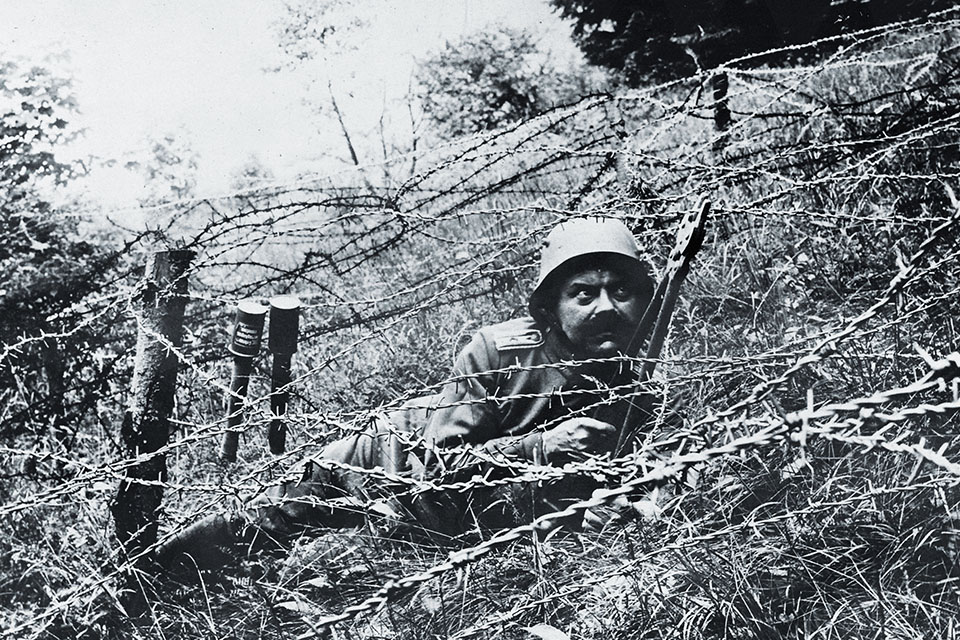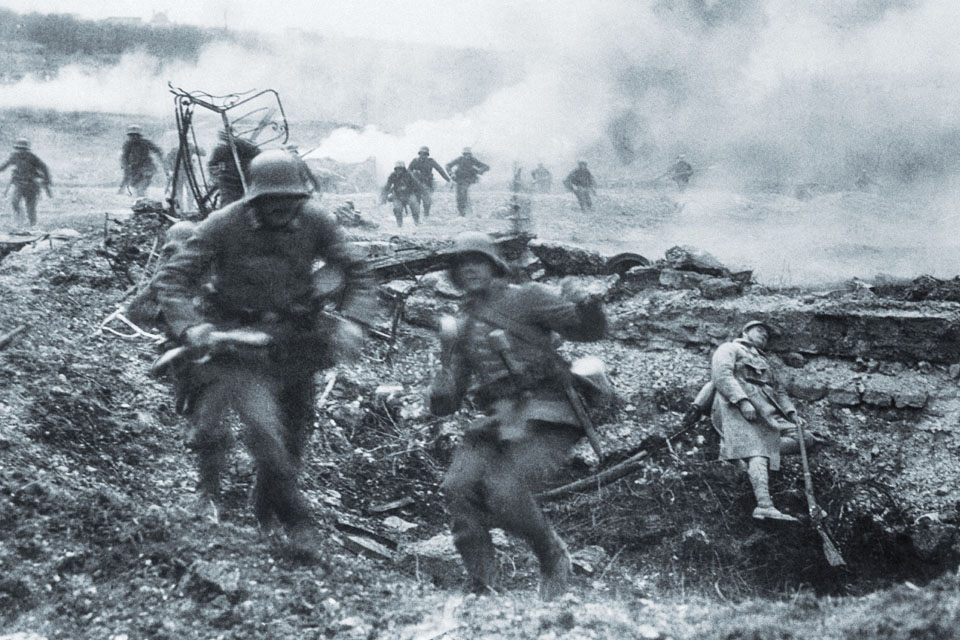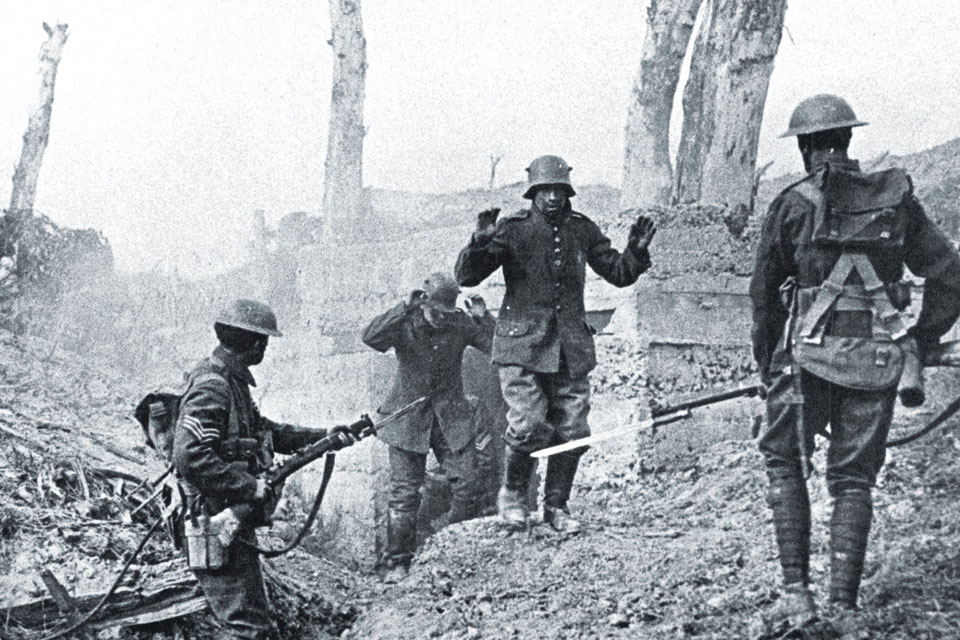As the Allies battled Germany during World War I, Colonel Fritz von Lossberg emerged as one of their most formidable—and fearsome—adversaries.
TO HIS CONTEMPORARIES IN THE GERMAN ARMY during World War I, Colonel Fritz von Lossberg was der Abwehrlöwe—the Lion of the Defensive. To some, Lossberg was “Ludendorff’s Fireman,” as he was one of the first officers General Erich Ludendorff summoned whenever things got really bad on the Western Front. Few officers in the 20th century have had as much influence on the development of modern military tactics. Lossberg played a key role in developing and proving on the battlefield many of the principles and techniques modern armies apply to the conduct of defensive operations, including defense in depth, flexible defense, and reverse-slope defense.
Lossberg didn’t command anything from 1914 to 1918, but he was the chief of staff of one corps, five different field armies, and two army groups. Under the German General Staff system of the time, a chief of staff was almost a co-commander and in many cases had more direct influence on the conduct of operations than the commander himself. From 1915 to late 1917 the German army was on the overall defensive on the Western Front—with the notable exception of the 1916 Verdun Offensive—and Lossberg directed virtually all of its major defensive battles.
FRIEDRICK KARL von LOSSBERG WAS BORN IN 1868 at Bad Homberg to an old Thuringian military family. In 1886 he joined the elite 2nd Foot Guards Regiment as an officer candidate. He was commissioned in 1887, and in 1894, while still a second lieutenant, he entered the vaunted Kriegsakademie, the Prussian war academy that was the primary training institution for German General Staff officers. After graduating from the three-year course, Lossberg served an additional two-year probationary period, finally achieving full qualification as a general staff officer in 1900. His career then followed the standard pattern, alternating between general staff and line assignments, including company and battalion command. Lossberg returned to the Kriegsakademie as an instructor from 1907 to 1910.
When World War I broke out, Lossberg was the chief of staff of the XIII Army Corps, which took part in the early fighting around Ypres, Belgium. In November 1914 the XIII Army Corps was redeployed to the Eastern Front. Three months later Lossberg was reassigned to the High Command of the German Field Army (Oberste Heeresleitung, or OHL) as deputy chief of the Operations Department. He hated his time at OHL, much preferring to be serving with combat troops. He got his chance to go back to the front when the French launched a major offensive in Champagne on September 25, 1915. The German Third Army in that sector immediately requested permission to pull back. Lossberg didn’t agree with its proposed course of action. Neither did General Erich von Falkenhayn, the chief of OHL. Falkenhayn immediately relieved the Third Army’s chief of staff, replacing him with Lossberg, who had specific orders to restore the tactical situation.
Lossberg was only a newly promoted colonel, but as soon as he reported, he requested and received vollmacht from his new commander. Vollmacht was a command-and-control concept unique to the German army. In the civilian context the word is translated as “power of attorney,” but there is no real English equivalent for the military application. Through the end of World War I, a senior general staff officer given vollmacht had the specific authority in emergency situations to issue direct orders to subordinate commanders in the name of the senior commander, even without having first checked with that commander. The technique was used very sparingly, but for the rest of the war Lossberg was entrusted with vollmacht on many occasions.
By early November the Germans had won the Second Battle of Champagne, inflicting some 450,000 casualties on the French in six weeks. Lossberg’s reputation as the master of the defensive was firmly established. In February 1916 Falkenhayn launched Germany’s offensive at Verdun. What turned into a massive battle of attrition failed in the end, but for 10 months the French army was under intense stress and came close to breaking. On July 1, to relieve the pressure on Verdun, the British and the French launched their great offensive at the Somme. Two days later OHL posted Lossberg to the Second Army as its chief of staff, again with orders to restore the situation. On July 19 OHL split General of Infantry Fritz von Below’s Second Army into the First and Second Armies. The Second Army was to deal with the French in the south, and the First Army was to defend against the more dangerous British in the north. Lossberg and Below went with the half that became the First Army.
The Battle of the Somme lasted until November 18 and was one of the worst bloodbaths in a war that was never short of carnage. It was a resounding operational defeat for the Allies. Fifty German divisions fought 51 British and 48 French divisions to a standstill. The British and French suffered an estimated 620,000 casualties, the Germans about 450,000. Lossberg was awarded the prestigious Orden Pour le Mérite (the order of merit also known as “The Blue Max”) for his role in the battle.

DURING THE BATTLE OF THE SOMME, Lossberg calculated that it took eight to 10 hours for a message to travel in either direction between a divisional headquarters and the front line, and far longer back to corps and army. Most telephone lines were cut as soon as the artillery started firing. From then on, almost everything depended on runners—assuming they even survived. The tactical situation always changed drastically during the time that it took information to flow up the chain of command and the corresponding orders to flow back down. Lossberg concluded that the only practical way to speed up tactical responsiveness was to give the frontline battalion commanders total control of their own sectors. That meant that the higher headquarters would have to support the decisions of the frontline commanders, who best knew the terrain and the situation.
For such a system to work, the frontline battalion commanders also had to have operational control of any reinforcements committed to their sectors—regardless of the size of the reinforcing unit or its commander’s rank—to ensure continuity of command. A frontline battalion commander would thus have the authority to withdraw from forward positions under pressure as the tactical situation demanded. More significantly, he would have the authority to commit his regiment’s remaining battalions to the counterattack when he judged the timing right.
On the Somme the three battalions of a regiment were typically deployed echeloned in column. The Forward Battalion held the first defensive position—actually a series of usually three or more roughly parallel and mutually supporting trench lines. The Immediate Reserve Battalion held the second defensive position. Farther to the rear, and generally beyond the range of the enemy’s artillery, was the Deep Reserve Battalion. Lossberg’s system effectively shortened the chain of command, with the regimental commander now managing the logistical support of his forward deployed battalions.
Although Lossberg initially was a proponent of rigid, forward defense, by the end of 1916 he was experimenting with emerging innovations in defensive techniques. Reverse-slope defense was something of a counterintuitive concept. With the main line of resistance sited just down from the ridgeline, away from the enemy, defenders had a much shorter field of fire. But they were screened rather effectively from enemy observation and masked from small-arms and artillery fire. Observers and defensive strongpoints on the front side of the slope provided early warning and called in targets for the German artillery positioned farther back. Attacking enemy forces were completely exposed when they arrived on the crest, and once they started down the defender’s side they were masked from their own artillery support.
The main idea was to trade space, where necessary, for time and especially enemy lives. The forwardmost ground was held by fire, not by men. Once the enemy attack culminated, the attacker would be subjected to an almost immediate counterattack before he could set his defense or bring his supporting elements forward. German doctrine recognized two basic types of counterattack: gegenstoss and gegenangriff. These are best translated into English as hasty counterattack and deliberate counterattack. Whenever possible, a German force pushed out of its initial defensive positions was expected to launch a gegenstoss before the enemy could consolidate or bring up enough forces and artillery to continue the attack.
In situations where the attacking force was just too strong or too well supported by its own artillery or air cover, such a hasty counterattack would only lead to more casualties. The commander of the forward battalion was given wide latitude in deciding whether a gegenstoss was feasible. If not, the standard procedure was to prepare to launch a deliberate counterattack, based on careful planning and the commitment of sufficient reinforcements and artillery. While the Allied command and control of attacks and counterattacks became increasingly centralized at ever-higher levels as the war progressed, the German lower-level commanders were gaining unprecedented autonomy and freedom of initiative.
Falkenhayn was sacked as chief of the general staff in July 1916. He was replaced by Field Marshal Paul von Hindenburg, with General Erich Ludendorff as his first quartermaster general (vice chief of staff). Ludendorff initiated a complete overhaul of German tactical doctrine on the Western Front, adopting many of Lossberg’s defensive innovations.

On December 1, 1916, OHL published the new doctrinal manual, Principles of Command in the Defensive Battle in Position Warfare. The primary principles underlying the new defensive techniques were flexibility, decentralized control, and counterattack.
DESPITE HIS OWN CONTRIBUTIONS TO THE NEW DOCTRINE, Lossberg thought the Principles went too far in permitting frontline unit commanders to yield ground in the face of a strong attack. He believed that a rigid forward defense was the best course of action whenever possible, with the flexible defense in depth reserved for crisis situations. And so Lossberg responded with his own analysis, Experiences of the First Army in the Somme Battles, which rebutted much of what was in the new Principles. Most military historians strongly criticize Ludendorff’s overall performance on the Western Front, particularly at the operational and strategic levels of warfare. On the tactical level, however, Ludendorff receives relatively high marks for encouraging healthy professional debate over tactical doctrine in the best traditions of the German General Staff. Ludendorff ordered OHL to reprint and widely distribute Lossberg’s pamphlet. The British later captured a copy, translated it, and printed 2,800 copies to distribute to their commanders.
The British launched a major offensive at Arras on April 1, 1917. The German Sixth Army operating in that sector was supposed to be defending on the new principles of flexible defense. The Germans, however, committed their reserves too late, allowing the attackers to penetrate into the German front on a wide sector. The British and Canadians captured the commanding high ground of Vimy Ridge, significantly pushing back the German lines. The defenders were facing a disaster in the making when Ludendorff telephoned Lossberg on April 3 to tell him he was being transferred immediately to the Sixth Army as its chief of staff.
Lossberg immediately asked Ludendorff for vollmacht—a significant departure from accepted practice, since the chief of staff was supposed to be granted vollmacht directly from his immediate commander. Lossberg was presuming to bypass both the commander of the Sixth Army, Colonel General Erich von Falkenhausen, and the commander of Army Group Crown Prince Rupprecht of Bavaria. Lossberg, still only a colonel, in effect was asking Ludendorff to designate him as the de facto commander of the Sixth Army. Not completely trusting the efficacy of the flexible defense doctrine, Lossberg believed that he needed almost unlimited command authority to rescue the situation. Ludendorff approved vollmacht without hesitation, and then informed the army and army group headquarters while Lossberg was en route. On getting word that Lossberg was on the way, Rupprecht’s chief of staff, General Hermann von Kuhl, said, “If anyone can straighten out this tangle, he will.”
Despite Lossberg’s serious reservations about the new defensive doctrine, Ludendorff had complete confidence that he would be able to stabilize the situation. Before Lossberg even reported to the Sixth Army headquarters, he went directly to the front lines, talked with the key commanders on the ground, and formulated his own assessment of the situation. He recognized immediately that by holding Vimy Ridge, the British had an overwhelming tactical advantage in artillery observation that made a German rigid forward defense completely impossible. In response, Lossberg started to establish a flexible defense in great depth, with the German forwardmost positions lightly manned.
Lossberg estimated that it would take the British at least three days to move their artillery forward over the ground they had recently captured. Until then, the British guns wouldn’t have the range necessary to support any continued advance. Lossberg used that time to reorganize and reinforce the Sixth Army’s new rearward main position and to establish a flexible defensive zone 18 miles wide and 10 miles deep, manned by 150,000 troops in 15 divisions.
The British resumed their offensive on April 14 with the goal of conducting a limited objective attack to expand the salients they had pushed into the German lines five days earlier. “When a more formal attack went in on the 14th it was very roughly handled,” Richard Holmes, the late British military historian, wrote. “The long ridges and shallow valleys enabled the Germans to employ elastic defense at its best, giving ground before the attack.” The British troops crossed their line of departure at 5:30 a.m., but the deeper they penetrated into the German positions, the more they encountered unanticipated resistance. By 8 a.m. most of the attackers were back in their own trenches, having taken up to 60 percent casualties in their lead units.
Thus, at Arras, one of the German army’s strongest critics of the widespread use of flexible defense in depth became the first to make it work in a large-scale battle. Lossberg later admitted that his defensive system at the Sixth Army ran counter to almost everything he had written in his Experiences pamphlet. Ironically, the heavy German casualties on the first day at Arras initially caused Ludendorff and others at OHL to doubt the efficacy of the new doctrine. But once Lossberg made the system work, it was clear that the tactics were sound. Errors in application on April 1 had been the problem. On April 24, 1917, Lossberg was awarded the Orden Pour le Mérite with Oak Leaves, a high honor given only 122 times during World War I. That August he was promoted to major general.
In early June 1917 German intelligence collected strong indicators of an imminent major British attack in the Ypres sector. Once again, Ludendorff sent Lossberg to the threatened Fourth Army, to take over as chief of staff. For once, Lossberg had sufficient time before the start of a battle to organize a defense. The British attacked on July 31. The Third Battle of Ypres, more commonly known as “Bloody Passchendaele,” raged on until November 20. By the time it was over, the British had managed to capture the key Passchendaele Ridge, but they had little besides some 300,000 casualties to show for it.
Now it was time for the Germans to go over to the offensive on the Western Front. Lossberg played no direct role in Operation Michael (March 21–April 4, 1918), the first of the five great “Ludendorff Offensives” of 1918. During the follow-on Operation Georgette (April 9–29), Lossberg’s Fourth Army attacked the British in support of the German Sixth Army, capturing Mount Kemmel on April 25, though the offensive failed overall. The Fourth Army played no role in the subsequent three German offensives, Blücher (May 27–June 5), Gneisenau (June 9–13), and Marneschutz-Reims (July 15–18). Following Marneschutz-Reims, which was a feint toward Paris to draw French reserves away from the British in Flanders, the Fourth Army was supposed to follow through with the long-planned and frequently postponed Operation Hagen—the final blow against the Allies intended to push the British off the Continent. The plan called for the Fourth Army to deliver the main effort with five corps and 29 divisions, supported on the left by Sixth Army with two corps and seven divisions.
The Hagen attack date was set for August 1, but Marneschutz-Reims failed and the Allies launched a robust counterattack into the German positions west of Reims on July 18. The German lines crumbled because they hadn’t had time to establish their own defenses after halting their fifth offensive. On July 19 Lossberg strongly recommended to Ludendorff that the Germans withdraw immediately to the Siegfried Line, their starting position for the offensives in March. A badly shaken Ludendorff refused to consider it. The following day Ludendorff summoned Lossberg to OHL. His nerves shattered, Ludendorff talked about resigning immediately. Lossberg talked him out of it, but later regretted doing so. Ludendorff then sent the German army’s defensive expert to the Soissons sector to assess the situation. By the time Lossberg returned to OHL on July 25, the overall situation had deteriorated further, and he was shocked to find that Ludendorff had not acted on any of his recommendations to shore up the German defensive lines.

IN AUGUST 1918 LOSSBERG BECAME THE CHIEF OF STAFF of Army Group von Boehn. By that point, however, the Germans no longer had any chance of winning World War I on the battlefield, or even of fending off inevitable defeat for much longer. Lossberg ended the war as the chief of staff of Army Group Duke Albrecht von Württemberg.
Following the war, Lossberg remained in the new Reichswehr, as the German army was known between the wars, and contributed to the tactical and organizational reforms of General Hans von Seeckt. In late August 1919 he was assigned to serve as the chief of staff of General Kommando II, one of only two corps-level formations in the 100,000-man Reichswehr. One of his subordinate staff officers was a young Captain Erich von Manstein, who during the Battle of the Somme in July 1916 had served under Lossberg as a First Army General Staff officer. Manstein would go on to become a field marshal and the Wehrmacht’s greatest general of World War II.
During the interwar years there was a great deal of debate, first within the Reichswehr and then the Wehrmacht, over the tactical and operational lessons of World War I. Since at least the days of Helmuth von Moltke the Elder, the offensive had been the overriding mantra of the German army. It was ironic, then, that the Germans proved to be the most effective defenders in World War I. In the 1920s and ’30s many German officers argued that trench warfare conditions of 1915–1918 had been an anomaly, and they pushed for a return to an overwhelming emphasis on the attack. Not all, however, agreed. In his influential 1938 book, Die Abwehr (The Defense), General (later Field Marshal) Wilhelm Ritter von Leeb warned against any overly doctrinaire and exclusive focus on offensive operations. In his discussion of the historical background of German defensive operations, he reviewed the major Western Front battles of 1915 to 1917 in which Lossberg had played so significant a role.
Leeb argued that Germany’s geographic position in central Europe, surrounded by potential enemies, combined with its comparative industrial and economic inferiority made it essential that Germany master defensive as well as offensive operations. Pursuing a directly opposite tack to many of the operational theorists of the day, Leeb argued that the dramatic improvements in mobility and weapons effects since 1918 made defensive capabilities even more necessary and at the same time opened up new operational and tactical possibilities for combat operations, both defensive and offensive. A pure defense, of course, could never produce decisive results in war. But offensive operations had to be focused on a concentrated objective, and an effective defense, therefore, was essential in all other sectors to facilitate massing the required forces for an attack.
To this day, the Wehrmacht is remembered primarily for its many stunningly successful offensive operations of World War II. Nonetheless, some German commanders during that war also conducted brilliant defensive operations against overwhelming numerical odds. Among them were Field Marshal Albert Kesselring in Italy, Field Marshal Erich von Manstein and General Hermann Balck on the Eastern Front, and Field Marshal Walther Model on both fronts.
In 1925 Lossberg assumed command of the Reichswehr’s General Kommando I, and the following year he was promoted to the three-star rank of general of infantry. He retired in January 1927. During World War II, his son Bernhard was a major general on the Wehrmacht’s Command Staff (Führungsstab). Lossberg died in Lübeck on May 14, 1942.
During his 41-year military career Lossberg was the quintessential German General Staff officer, and he was recognized as such by his peers. He was arguably the best chief of staff the Germans had during World War I. In January 1918 OHL issued its official after-action analysis of the 1917 Battle of Arras. Citing Lossberg’s contribution, the report credited the outcome of the battle to “the prodigious creative mental energy of this exceptional man.” MHQ
DAVID T. ZABECKI is MHQ’s chief military historian. He and Dieter J. Biedekarken have edited and translated Fritz von Lossberg’s World War I memoirs (published in Berlin in 1939 as Meine Tätigkeit im Weltkriege 1914–1918) into English. Their book, Lossberg’s War: The World War I Memoirs of a German Chief of Staff, is to be published this year by the University Press of Kentucky.
Photo: Wikimedia Commons
[hr]
This article appears in the Summer 2017 issue (Vol. 29, No. 4) of MHQ—The Quarterly Journal of Military History with the headline: The Kaiser’s Grim Reaper
Want to have the lavishly illustrated, premium-quality print edition of MHQ delivered directly to you four times a year? Subscribe now at special savings!






